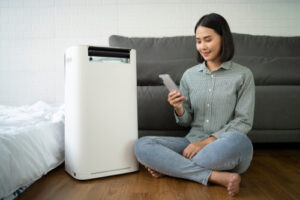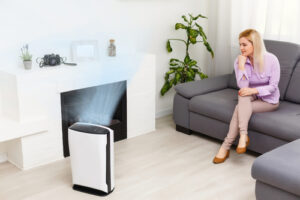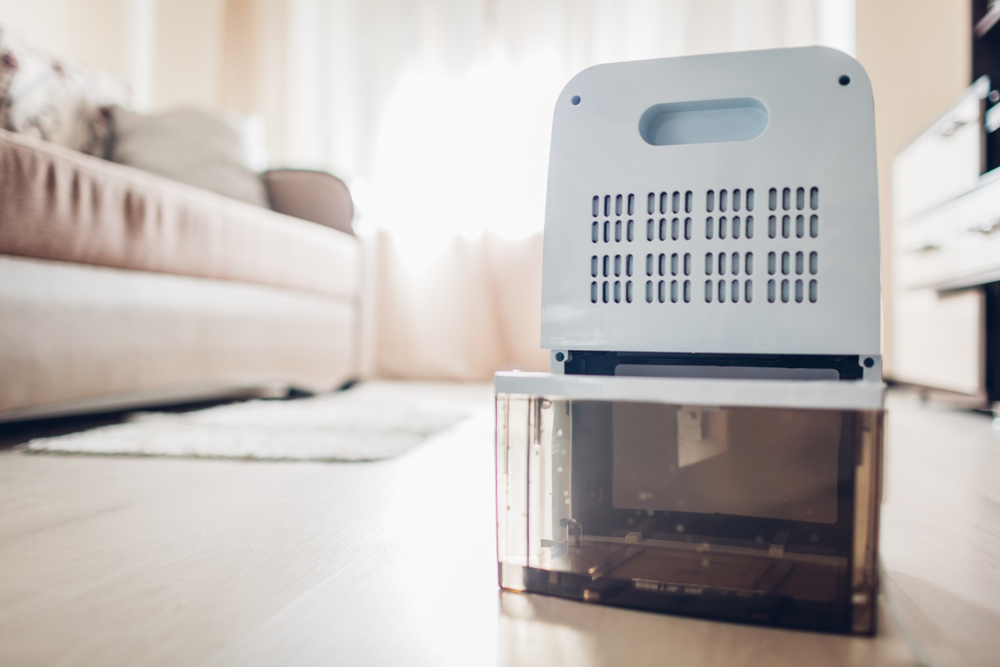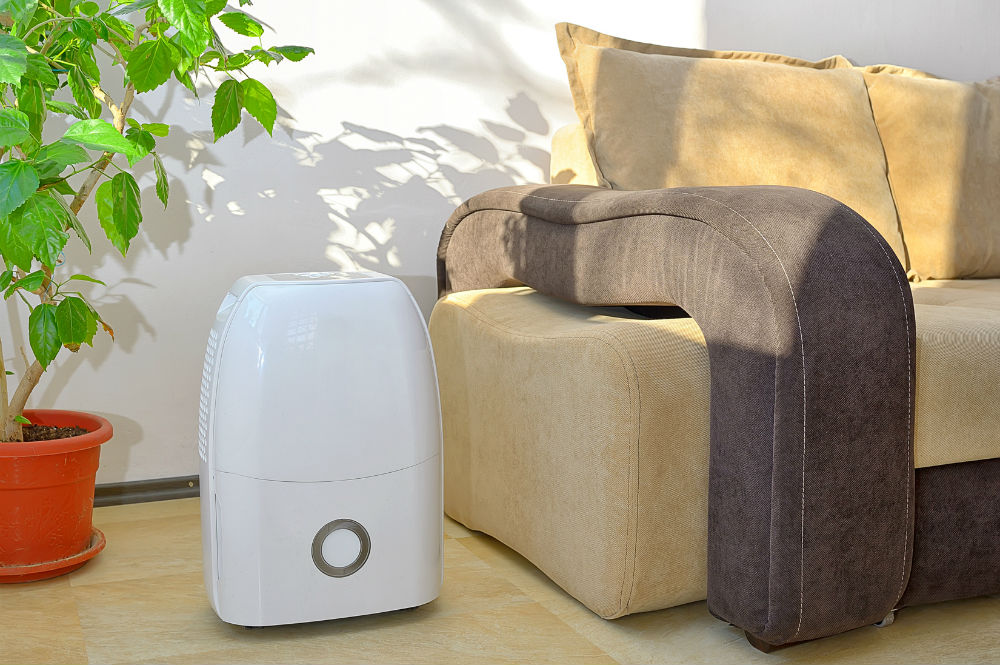Do you like the concept of owning a dehumidifier but are worried about the cost?
You are not alone – many homeowners avoid dehumidifiers over concerns about monthly energy costs.
But do you know how much it really costs to run a dehumidifier? The answer is probably less than you think.
But the operating cost of a dehumidifier depends on various factors including the size, type, and others.
In this article we’ll explain how to estimate the cost of your next dehumidifier, so you can buy with confidence.
Does a Dehumidifier Need to Run 24/7?
How long a dehumidifier needs to run depends on various factors such as room dimensions and humidity level.
Newer, tightly sealed homes will usually have higher relative humidity and will benefit from running a dehumidifier regularly.
It’s recommended that you maintain the relative humidity in your home between 40 and 60 percent to prevent mold and other germs from multiplying.
As soon as you get the humidity below 60 percent, you can experiment with various settings and times to find what suits you best.
Many modern dehumidifiers are fitted with a timer and a humidistat that lets you set your favorite humidity level and the machine will take care of keeping it there. The dehumidifier will continue to operate until the set humidity is achieved, then turn off until the humidity gets too low.
Another intelligent feature to look for is an auto-shutoff that turns the unit when the wastewater bucket is full.
So the answer here is: yes, you can run your dehumidifier for 24 hours daily, but most dehumidifiers aren’t really designed for continuous use and it will put a strain on the inner components. And it’s probably unnecessary.
What is the Average Cost of Running a Dehumidifier?
How much it costs to run a dehumidifier depends mainly upon the capacity of the device.
Generally speaking, smaller dehumidifiers – also called mini dehumidifiers – cost about $25 a year to dehumidify a small room.
However, as the dehumidifier grows in size, so do the bills.
Larger units capable of dehumidifying an entire home can cost $350 annually. This refers mostly to larger units which are 70-pints or more.
How to Compute the Energy Cost of Your Dehumidifier

How much power your dehumidifier uses depends on the number of watts it uses along with your existing power rate.
It can be tricky to know precisely how much it will cost you, but you can make a rough estimate.
Before you begin, there are two things that you need to know:
- How much your utility company charges ($ per kilowatt-hour): You can get this from your monthly utility bill.
- How much energy your dehumidifier consumes (watts): If your dehumidifier only lists volts and amps, then multiply volts times amps to get your wattage. Then, divide the watts by 1,000, so it is in kilowatts.
Once you have these two amounts, multiply them to estimate the cost per hour to run your dehumidifier.
You will discover that a whole-house dehumidifier runs continuously at first. This is done to learn the humidity in your air and remove moisture that has accumulated over time on your furniture, cabinets, walls, and other surfaces. It can take a few weeks for your dehumidifier to maintain the humidity where you want it.
That’s why your initial energy bill will likely be the most costly one.
When the dehumidifier is effectively managing around the setpoint humidity level, you will see the fan runs more often by itself and that the unit shuts itself off for hours between cycles. At this point, your dehumidifier will run for perhaps 4 to 12 hours a day.
The season and weather also affect your power bill. The dehumidifier may be on continually during a rainy day, for example. Considering that the dehumidifier blows warm, dry atmosphere after it completes the water extraction method, this may help you in the winter but not in the summer.
In the winter, the warm air coming out of a dehumidifier helps warm the house, so you will realize that your device will turn on less often to warm the home.
It’s impossible to predict precisely how many hours a dehumidifier will operate daily. The Department of Energy (DOE) says that the dehumidifier will almost be off in the winter. Then, run between April and October.
The best way to keep active running time as low as possible is to purchase a dehumidifier that is exactly the correct size for your house.
But how can you do that?
Picking the Perfect Size

If you buy a dehumidifier that is the wrong fit for your space, your dehumidifier will run constantly and waste gobs of energy in the process. Be cautious about trusting what the manufacturer recommends as the appropriate size of this room.
You’ll often encounter dehumidifiers advertised to work in 3,000 or 4,000 square feet homes or more – but make sure that you understand what that means.
Be Careful with Mini Dehumidifiers. It can be enticing to purchase a cheap dehumidifier that costs only a few dollars each month to run, but you really must know what you are getting and what your needs are.
Airflow

Find the user guide or product specifications and search for the cubic feet per minute (cfm) number. This lets you know how strong the dehumidifier’s fan is at transferring the air inside a given space. To put it differently, it is a measure of airflow.
If this amount is low, certain, the dehumidifier may ultimately cycle all of the air in the room, but you might not need it to be running daily to accomplish this?
The higher the cfm, the less time that the dehumidifier should cycle the air in a room. A dehumidifier can cycle the air within a room per hour, known as the ACH (air change rate). Having the ability to cycle air more often at a quicker rate translates into the dehumidifier using less electricity and spending more time in idle mode.
When looking at airflow, start looking for units in cubic feet per minute. Often manufacturers use cubic meters per hour, so you will need to convert to cubic feet per minute to have the ability to compare dehumidifiers properly.
The Starting Humidity Level
Airflow is especially critical for damp basements and bathrooms. A low ACH together with a moist basement is going to be a disaster in your energy bill. The dehumidifier will always be on!
For normal rooms, start looking for ACH rates 4 or 3, which means that the air cycles after every 15 to 20 minutes. For damp areas, start looking for ACH rates 5 or 6, which means that the air cycles after every 10 to 12 minutes.
As you can tell, the beginning level of humidity is vital. It requires more work to take the air out of a 90% to 50% humidity level than to do it from 65% to 50%. If the brand recommends a dehumidifier for use in a 500 square feet area (4,000 cubic feet when it’s an 8-foot ceiling), keep in mind that this is most likely to get a room that is only slightly moist.
If the room is very moist, a 14-pint dehumidifier range that was suggested for a 1,000 square feet area abruptly can only work in the space of 500 square feet.
Temperature

The warmer the ambient temperature is at a house, the more efficiently the dehumidifier works. Sadly, this is something that manufacturers use to show their dehumidifiers to be more effective.
Most dehumidifiers are analyzed at a temperature that is a little warmer than the temperature that many people set in their central thermostat.
In reality, the temperature of a space is much more significant than the initial relative humidity (RH) when it comes to dehumidifiers.
Dehumidifiers can be rated according to a standard called AHAM DH-1, which is named after the company that places it (Association of Home Appliance Manufacturers). When dehumidifiers are analyzed under AHAM, it means they’re examined in a closed area with a relative temperature of 80 º and a Fhumidity (RH) of 60%.
The DH-1 test also includes Energy Star standards, so the AHAM standard is usually regarded as a good one. Additionally, it is voluntary, so producers that subject their units to AHAM testing are regarded as more transparent by customers. But the issue is that most homes are not generally kept at 80 ºF.
Let’s take a Look at how a dehumidifier works comparing the AHAM standard (80 ºF) to a similar European standard, which utilizes 86 ºF as the test temperature (you can find them online by simply performing a basic Google search):
Listed Pint Capacity Of Dehumidifiers
Product
AHAM:
80 ºF / 60% RH
European:
86 ºF / 80% RH
Other
Inofia Portable Dehumidifier, 30-Pints
n/a
25.4 pints
32.8-pints
(at 86 ºF / 90% RH)
SPT SD-31E Dehumidifier, 30-Pint
30-pints
45-pints
n/a
AlorAir HDi90 Dehumidifier
90-pints
n/a
198-pints
(at saturation: 90 °F,90% RH)
Eurgeen Mid-Sized 20 Pint Dehumidifier
10-pints
20 pints
n/a
AlorAir HD55 Dehumidifier
55-pints
n/a
120-pints
(at saturation: 90 °F,90% RH)
According to that, you should tell a dehumidifier can initially eliminate more water if it is in an environment with high temperature and high beginning humidity levels.
This approach is by no means exclusive to the cases listed above.
All conventional dehumidifiers can usually extract more moisture from the air at elevated humidity and temperature levels. It’s to do with the coils within the dehumidifier that convert the gaseous water to condensate.
When the temperature is low, frost is likely to form on these coils, making the system less capable of collecting water. It is also easier to extract water from the air when there is already lots of air (meaning that there’s more saturation).
That’s why it’s essential to realize where your living room fits in this spectrum.
Also, it helps to understand what the manufacturer’s suggestions mean for your circumstances.
I’m a degreed ME (mechanical engineer) who is passionate about machines of all kinds. I created MachineWonders.com as a way to connect with others who love machines like me – or need help choosing one for their needs, application, or situation.



